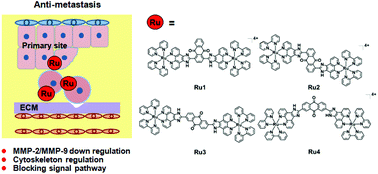Anthraquinone-bridged diruthenium(ii) complexes inhibit migration and invasion of human hepatocarcinoma MHCC97-H cells†
Abstract
Metastasis is a major health threat for most cancer patients, thus anti-metastasis treatments that reduce cell migration and invasion are critical for cancer treatment. In this study, four anthraquinone-bridged diruthenium(II) complexes, [(bpy)2Ru(L)Ru(bpy)2]4+ (Ru1, L = 1,4-bis(1H-imidazo[4,5-f][1,10]phenanthrolin-2-yl)anthracene-9,10-dione; Ru2, L = 1,5-bis(1H-imidazo[4,5-f][1,10]phenanthrolin-2-yl)anthracene-9,10-dione; Ru3, L = 2,6-bis(1H-imidazo[4,5-f][1,10]phenanthrolin-2-yl)anthracene-9,10-dione; and Ru4, L = 2,7-bis(1H-imidazo[4,5-f][1,10]phenanthrolin-2-yl)anthracene-9,10-dione) were synthesized and characterized. These Ru(II) complexes exhibited multi-targeted anti-metastatic properties against human hepatocarcinoma MHCC97-H cells that included the inhibition of migration and invasion. Further investigation of the intracellular mechanisms revealed that Ru(II) complexes suppressed the phosphorylation of ERK and AKT. Moreover, significant reduction of the extracellular and intracellular expression of the metastatic regulatory proteins MMP-2 and MMP-9 was also observed after Ru1–Ru4 treatment. In addition, these Ru(II) complexes negatively modulate the actin cytoskeleton by inhibiting Cdc42 protein expression, arresting the cells in the G2/M phase. The results indicate that these ruthenium(II) complexes have potential as drug candidates for anti-metastatic therapies.



 Please wait while we load your content...
Please wait while we load your content...